
The Phoenix Buildings are heritage-listed commercial buildings at 647 Stanley Street, Woolloongabba, City of Brisbane, Queensland, Australia. They were designed by Richard Gailey and built from 1889 to 1890 by James Rix. They were added to the Queensland Heritage Register on 24 May 1995.

The Port Office is a heritage-listed former government building at 39 Edward Street, Brisbane City, City of Brisbane, Queensland, Australia. It was designed by Francis Drummond Greville Stanley and built from 1879 to 1929 by John Petrie. It is also known as Stamford Plaza and Harbours & Marine Building. It was added to the Queensland Heritage Register on 21 October 1992.

National Australia Bank is a heritage-listed bank building at 308 Queen Street, Brisbane City, City of Brisbane, Queensland, Australia. It was designed by Francis Drummond Greville Stanley and built from 1881-1924 by Southall & Tracey. It is also known as Queensland National Bank. It was added to the Queensland Heritage Register on 21 October 1992.

Gympie Stock Exchange is a heritage-listed former bank building and former stock exchange at 236 Mary Street, Gympie, Gympie Region, Queensland, Australia. It was designed by Francis Drummond Greville Stanley and built from 1881 to 1882. It is also the former Australian Joint Stock Bank and the Neilson, Stanton and Parkinson Building. It was added to the Queensland Heritage Register on 15 April 2011.

Australian Joint Stock Bank Building is a heritage-listed former bank and now museum at 331 Kent Street, Maryborough, Fraser Coast Region, Queensland, Australia. It was designed by Francis Drummond Greville Stanley and built in 1882 by French & Crystall. It was also known as the Department of Primary Industries Building, the Union Bank building, and the Office of Sport and Recreation. It was added to the Queensland Heritage Register on 21 October 1992.

Rockhampton Courthouse is a heritage-listed courthouse at 42 East Street, Rockhampton, Rockhampton Region, Queensland, Australia. It was designed by John Hitch and built from 1950 to 1955. It is also known as District Court, Queensland Government Savings Bank, Commonwealth Bank, Magistrate's Court, Police Court, and Supreme Court. It was added to the Queensland Heritage Register on 21 October 1992.

Maryborough Heritage Centre is a heritage-listed former bank building at 164 Richmond Street, Maryborough, Fraser Coast Region, Queensland, Australia. It was designed by George Allen Mansfield and James Cowlishaw and built in 1877 for the Bank of New South Wales. It is also known as National Parks and Wildlife Service Headquarters, Post Master General's Department, and Telecom Building. It was added to the Queensland Heritage Register on 21 October 1992.

Commercial Bank of Sydney is a heritage-listed former bank building at 191–193 Bourbong Street, Bundaberg Central, Bundaberg, Bundaberg Region, Queensland, Australia. It was designed by George Allen Mansfield and built in 1891. It is also known as the National Australia Bank. It was added to the Queensland Heritage Register on 21 October 1992.
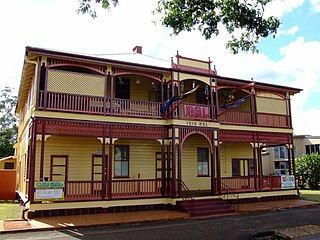
Childers RSL Club is a heritage-listed former bank and now Returned and Services League of Australia club house at 55 Churchill Street, Childers, Bundaberg Region, Queensland, Australia. It was designed by James Percy Owen Cowlishaw and built from 1900 to c. 1909. It was formerly a branch of the Commercial Banking Company of Sydney and is also known as the RSSAILA Club or the Isis RSL Club. It was added to the Queensland Heritage Register on 21 October 1992.
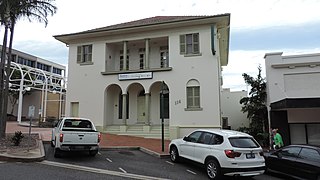
Commonwealth Bank Building is a heritage-listed former bank building at 114 Goondoon Street, Gladstone Central, Gladstone, Gladstone Region, Queensland, Australia. It was built from 1928 to 1929. It was added to the Queensland Heritage Register on 28 July 2000.
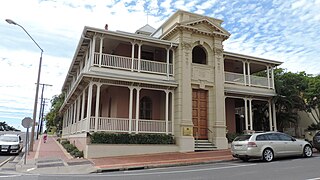
Kullaroo House is a heritage-listed former bank building at 40 Goondoon Street, Gladstone, Gladstone Region, Queensland, Australia. It was designed by James Percy Owen Cowlishaw and built from 1910 to 1911 by A A Carrick. It is also known as Commercial Banking Company of Sydney Ltd. It was added to the Queensland Heritage Register on 5 March 1999.

Nebo Hotel, also known as Fort Cooper Hotel, is a heritage-listed hotel at 2 Reynolds Street, Nebo, Isaac Region, Queensland, Australia. It was built in 1886 and was added to the Queensland Heritage Register on 27 October 2000.
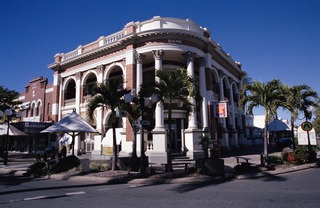
Queensland National Bank is a heritage-listed former bank building at 79 Victoria Street, Mackay, Mackay Region, Queensland, Australia. It was designed by Frederic Herbert Faircloth and constructed by local builder, William Patrick Guthrie, in 1923. It is also known as Hogs Breath Cafe and Metway Building. It was added to the Queensland Heritage Register on 21 October 1992.

The WH Paxton & Co. Buildings are a heritage-listed group of offices and warehousing at 10 River Street, Mackay, Mackay Region, Queensland, Australia. The 1899 sections were designed by Mackay architect Arthur Rigby and constructed by Charles Porter and Joseph Vidulich (warehouse). The 1912 warehouse extension was designed by Brisbane architect Montague Talbot Stanley. It was added to the Queensland Heritage Register on 14 August 2008.

Queensland National Bank is a heritage-listed former bank at 295-303 Flinders Street, Townsville CBD, City of Townsville, Queensland, Australia. It was designed by Francis Drummond Greville Stanley and built from 1878-1879 by C A Ward. It was added to the Queensland Heritage Register on 28 January 1994.

The Magnetic House is a heritage-listed office building at 143-149 Flinders Street East, Townsville, City of Townsville, Queensland, Australia. It was designed by C H E Blackmann & John Sulman and built from 1886 to 1888 by Dennis Kelleher. It was later known as Magnetic House. It was added to the Queensland Heritage Register on 21 August 1992.
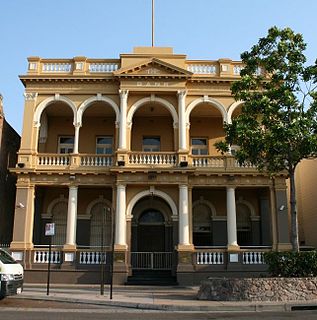
Australian Joint Stock Bank Building is a heritage-listed bank at 173 Flinders Street, Townsville CBD, City of Townsville, Queensland, Australia. It was designed by Francis Drummond Greville Stanley and built from 1887 to 1888 by MacMahon & Cliffe. It is also known as Australian Bank of Commerce and The Bank Nite Club. It was added to the Queensland Heritage Register on 21 October 1992.

Commonwealth Bank Building is a heritage-listed former bank building at 272-278 Flinders Street, Townsville CBD, City of Townsville, Queensland, Australia. It was designed by John and Herwald Kirkpatrick and built in 1923 by Charles Hanson & Sons. It is also known as Commonwealth Savings Bank and Townsville City Council Library. It was added to the Queensland Heritage Register on 29 October 2004.

Westpac Bank Building is a heritage-listed former bank building at 120 Charlotte Street, Cooktown, Shire of Cook, Queensland, Australia. It was designed by Francis Drummond Greville Stanley and built from 1891 to 1891. It is also known as Bank of New South Wales and Queensland National Bank. It was added to the Queensland Heritage Register on 11 March 1994.
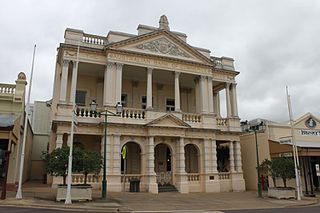
Australian Bank of Commerce is a heritage-listed former bank building at 86 Mosman Street, Charters Towers City, Charters Towers, Charters Towers Region, Queensland, Australia. It was designed by Francis Drummond Greville Stanley and built in 1891 by Wyatt & Gates. It is also known as The Australian Joint Stock Bank and is now The World Theatre. It was added to the Queensland Heritage Register on 21 October 1992.























